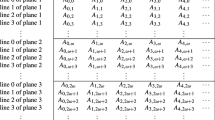Abstract
In The Revision Theory of Truth (MIT Press), Gupta and Belnap (1993) claim as an advantage of their approach to truth “its consequence that truth behaves like an ordinary classical concept under certain conditions—conditions that can roughly be characterized as those in which there is no vicious reference in the language.” To clarify this remark, they define Thomason models, nonpathological models in which truth behaves like a classical concept, and investigate conditions under which a model is Thomason: they argue that a model is Thomason when there is no vicious reference in it. We extend their investigation, considering notions of nonpathologicality and senses of “no vicious reference” generated both by revision theories of truth and by fixed-point theories of truth. We show that some of the fixed-point theories have an advantage analogous to that which Gupta and Belnap claim for their approach, and that at least one revision theory does not. This calls into question the claim that the revision theories have a distinctive advantage in this regard.
Similar content being viewed by others
References
Brandom, R. (1994). Making it explicit: Reasoning, representing and discursive commitment. Harvard University Press.
Cook, R. (2006). There are non-circular paradoxes (but Yablo’s isn’t one of them!). The Monist, 89, 118–149.
Grover, D. (1977). Inheritors and paradox. Journal of Philosophy, 74, 590–604.
Grover, D., Camp, J., & Belnap, N. (1975). A prosentential theory of truth. Philosophical Studies, 27, 73–125.
Gupta, A. (1982). Truth and paradox. Journal of Philosophical Logic, 11, 1–60. Reprinted in Recent essays on truth and the liar paradox (R. L. Martin, ed.), Oxford University Press, 1984, pp. 175–236 (page references are to this reprinting).
Gupta, A., & Belnap, N. (1993). The revision theory of truth. MIT Press.
Kremer, M. (1988). Kripke and the logic of truth. Journal of Philosophical Logic, 17, 225–278.
Kremer, P. (2009). Comparing fixed-point and revision theories of truth. Journal of Philosophical Logic, 38, 363–403.
Kripke, S. (1975). Outline of a theory of truth. Journal of Philosophy, 72(19), 690–716.
Martin, R. L., & Woodruff, P. W. (1975). On representing ‘True-in-L’ in L. Philosophia, 5, 217–221.
McGee, V. (1991). Truth, vagueness and paradox: An essay on the logic of truth. Indianapolis: Hackett.
Yablo, S. (1993). Paradox without self-reference. Analysis, 53, 251–252.
Author information
Authors and Affiliations
Corresponding author
Rights and permissions
About this article
Cite this article
Kremer, P. How Truth Behaves When There’s No Vicious Reference. J Philos Logic 39, 345–367 (2010). https://doi.org/10.1007/s10992-010-9136-4
Received:
Accepted:
Published:
Issue Date:
DOI: https://doi.org/10.1007/s10992-010-9136-4




